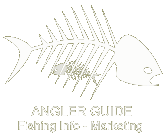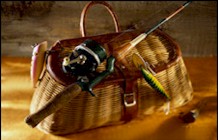Norris Lake is
nestled Between the foothills of the Great Smoky
Mountains and the Cumberland Mountains. Norris was the first
reservoir to be constructed by the Tennessee
Valley Authority (TVA). When the dam was completed
in 1936, its closing impounded the Clinch and
Powell Rivers, flooding 34,200-acres of mostly
farmland, timber and small village sites. Norris
Reservoir’s primary purposes are flood control and
hydroelectric power production. TVA also uses
Norris water to maintain minimum navigational
channel depths on reservoirs farther downstream.
Its multiple demands subject the reservoir to wide
fluctuations in water elevation. 34,200-acres of mostly
farmland, timber and small village sites. Norris
Reservoir’s primary purposes are flood control and
hydroelectric power production. TVA also uses
Norris water to maintain minimum navigational
channel depths on reservoirs farther downstream.
Its multiple demands subject the reservoir to wide
fluctuations in water elevation.
Annual water elevation
fluctuations can exceed 45-feet. The fluctuation,
coupled with detrimental effects of wave action,
has severely eroded Norris’ 800-miles of
shoreline, washing away fish habitat, topsoil and
much of the associated nutrients needed to support
aquatic life. Most of the nutrient supply comes
from the inflow of the Clinch and Powell rivers.
Since its beginning, Norris has experienced a
progressively diminishing nutrient base and a
corresponding reduction in its ability to support
as many fish as in more fertile reservoirs.
During summer
months, the lake is subject to vertical
stratification. With rare exception, dissolved
oxygen and water temperatures related to the
stratification do not cause problems with respect
to fish survival.
There are no health
advisories issued for the consumption of any fish
species in Norris. The reservoir has 38 public
boat-launching ramps. Anglers may contact TVA
(800-627-7882) or The Map Store in Knoxville
(888-929-6277 or 865-688-3608) for reservoir maps.
Some local retail stores also carry maps of area
lakes.
FISH
HABITAT ENHANCEMENT:
The TWRA and
volunteers from the public sector, have worked to
improve fish habitat in Norris for many years.
 More than 21,000
structures have been placed in the lake since
1992. A wide variety of fish attractors have been
used in an attempt to concentrate fish for
anglers. These include brush piles which are used
by many game fish, and stake beds which are
primarily for concentrating crappie. These
attractors work well, but must continually be
refurbished. More than 21,000
structures have been placed in the lake since
1992. A wide variety of fish attractors have been
used in an attempt to concentrate fish for
anglers. These include brush piles which are used
by many game fish, and stake beds which are
primarily for concentrating crappie. These
attractors work well, but must continually be
refurbished.
Bald cypress and
black willow trees have been planted in drawdown
areas to create additional, long lasting habitat.
Shoreline seeding
of grasses during the winter drawdown has the
potential of creating spawning habitat and cover
for young fish. Inconsistent water levels,
however, have rendered any shoreline seeding
projects impractical.
Spawning benches
have been constructed to provide habitat for
smallmouth bass reproduction.
BLACK BASS:
- Largemouth bass
stocking: 1995 - 114,860
The three species
of black bass accounted for about 32-percent of
the total angling pressure during 2003.
Spotted (Kentucky)
bass make up a good percentage of the black bass
population in Norris. Unlike largemouth and
smallmouth, this species rarely reaches quality
size in any East Tennessee reservoir. They also
utilize the same habitat and compete with the more
quality-sized smallmouth bass. As a result,
anglers are encouraged to keep these fish for the
table. There is no size restriction and the limit
is 15 spotted bass, per day.
Norris is noted for
its winter smallmouth fishing. The best fishing is
from November to April. There were an estimated
26,675 smallmouth caught by anglers in 2003 at an
averaged weight of 3.2 lbs. The current smallmouth
regulation allows five fish (in combination with
largemouth) per day with a minimum length limit of
18-inches.
STRIPED
BASS:
- Striped bass
stocking: 2005 - 103,655; 2004 - 103,196; 2003 -
103,489; 2002 - 104,200; 2001 - 105,857; 2000 -
103,607; 1999 - 102,685; 1995 - 204,416
Eighteen percent of
the total Norris angling pressure in 2003 was for
striped bass.
Norris yielded a
49.5 lb state record striped bass in April, 1978.
A recent fish kill in 2003 which was related to
water quality issues has severely reduced the
number of large stripers in the reservoir. It will
take several years for the fishery to recover and
begin producing good numbers of the >30-40 pound
fish that were common in the past.
Stocking was
suspended in 1996-1998 pending the outcome of a
food habit/competition study. Previous food-habit
studies have shown a preference for shad; and few
non-shad species have ever been found in striper
stomachs. The study concluded that few game fish
were consumed by stripers. There is a potential
for limited forage production during some years.
As a result, stocking rates have been reduced to
three per acre.
As of March 1,
2005, anglers are allowed one 36-inch or larger
fish from November-March and two, 15-inch or
larger fish from April-October.
CRAPPIE:
- Crappie
stocking: 2005 - 149,125; 2004 - 143,434; 2003 -
107,658; 2002 - 119,137; 2001 - 314,120; 2000 -
327,951; 1999 - 340,844; 1996 - 79,586
Since natural
reproduction of crappie has been below average
during the past several years and densities are
less than desirable, an aggressive stocking
program using blacknose black crappie was begun in
1999. The decline in lake fertility and loss of
habitat structure are two important aspects of
reservoir aging adversely affecting this game
fish.
Much of the habitat
work undertaken on Norris has been to improve the
crappie population and increase angler success
rates.
There is a daily
creel limit of 10 crappie with a minimum size
limit of 10-inches.
WALLEYE:
- Walleye
stocking: 2005 - 260,144; 2004 - 173,354; 2003 -
171,594, 2002 - 313,214, 2001 - 336,878, 2000 -
347,465, 1999 - 334,878
Walleye accounted
for over 17 percent of the total angling effort in
2003 and they are abundant in the reservoir. The
greatest fishing pressure for this species is in
the early spring during the annual spawning runs,
but many are also caught throughout the reservoir
during all seasons.
An aggressive
campaign was begun in 1999 to offset the negative
impacts of a failure in natural reproduction.
These stockings have proven to be extremely
successful.
Two strains and
three distinct populations of walleye exist in
Norris. The Lake Erie strain, stocked in the early
years, is adapted to spawn on gravel points, while
the Greers Ferry strain is adapted to making
annual spawning runs in rivers. Current stocking
uses brood fish obtained directly from Norris.
FISHING
TIPS:
Spotted
bass - Small white spinners, plastic
grubs on leadhead jigs, doll flies, and crawfish
crankbaits are excellent.
Largemouth
bass - Crankbaits, top water lures,
Flukes, Bass Assassins, spinners, and
Carolina-rigged lizards all work during April,
May, and early June.
Smallmouth
bass - Good lures for Norris smallmouth
are Silver Buddies, 1/4 oz (or smaller) doll
flies, doll flies tipped with minnows,
float-and-fly rigs, and large shiners. On windy
days in late winter, cast small crankbaits to
wind-swept, rocky banks. Early spring smallmouth
spawn on gravel points which reach out into the
main channels. Spinners or pig’n jigs fished at
night on steep, boulder-strewn banks catch good
smallmouth year-‘round.
Crappie
- Quality angling is best in the back of major
embayments such as Big Sycamore Creek, Davis Creek
and Big Creek. Upper river sections above Point 15
(Powell R.) and Point 31 (Clinch R.) are also
good. Fish brush piles or downed trees in the
winter, early spring or late fall months. Small
minnows, plastic grubs, flies tipped with minnows,
and small crankbaits work best.
Walleye
- During river runs, troll or jig with
minnow-tipped doll flies, Sparkle Tails, AC
Shiners, Rapalas, or Shad Raps. In late spring,
night anglers cast crankbaits into flooded weeds.
Trolling with Jet Lures tipped with night
crawlers, spinner-and-night crawler rigs, or with
deep running Long-Billed Rebels and Model 911
RedFins is popular by the end of May on the lower
end. Night fishing with jigging spoons, alewife or
shad accounts for good catches in the summer. |





